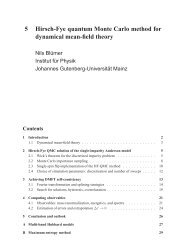Hubbard Model for Asymmetric Ultracold Fermionic ... - KOMET 337
Hubbard Model for Asymmetric Ultracold Fermionic ... - KOMET 337
Hubbard Model for Asymmetric Ultracold Fermionic ... - KOMET 337
Create successful ePaper yourself
Turn your PDF publications into a flip-book with our unique Google optimized e-Paper software.
2.3. SELF-CONSISTENCY EQUATIONS 13well-known, since the grand canonical Hamiltonian commutes with the Bogoliubov numberoperator ¯n kσ . The thermodynamic averages in the grand-canonical ensemble can be writtenas:〈b † kσ b k ′ σ ′ 〉 = δ kk ′δ σσ ′f β(E kσ) ; 〈b kσb k ′ σ ′ 〉 = 〈b † kσ b† k ′ σ ′ 〉 = 0 , (2.39)since, at Hartree-Fock level, the Bogoliubov-quasiparticles do not interact. Here f β (x) is theFermi function at inverse temperature β:f β (x) =1exp(βx) + 1. (2.40)The averages of the occupation numbers are of course given by: 〈n kσ〉 = 〈c † kσ c kσ〉. Thesemay be expressed with the help of the inverse Bogoliubov-trans<strong>for</strong>mation as follows:〈c † kσ c kσ 〉 = cos2 (α kσ)〈b † kσ b kσ 〉 + sin2 (α kσ)〈b −k−σb † −k−σ 〉 (2.41)〈c † k↑ c† −k↓ 〉 = cos(α k↑ )sin(α k↑ )e−iδ 〈b † k↑ b k↑ − b −k↓ b† −k↓ 〉 (2.42)〈c −k↓c k↑〉 = 〈c † k↑ c† −k↓ 〉∗ , (2.43)since from (2.39) we know that pair creation/annihilation terms of Bogoliubov-quasiparticlesdo not contribute. Using that our parameters are supposed to be translationally invariant, wedirectly obtain our self-consistency equations by per<strong>for</strong>ming a k-summation and using thatdouble products of sine and cosine functions of an angle α may be expressed as sine or cosinefunctions of the double angle 2α. With the help of (2.29) we finally get:n = 1 + 1 Nm = 1nN∆ =U∆2N∑kσ∑ |E k|(√ f β (E kσ) − 1 ), (2.44)Ek 2 + U2 |∆| 2 2kσ|E k|σ√E 2 k + U2 |∆| 2 f β (E kσ) and (2.45)∑ sign(E k) (√ f β (E kσ) − 1Ek 2 + U2 |∆| 2 2kσ). (2.46)These equations are only valid in the thermodynamic limit, so that we replace the d-dimensionalk-summation by a one-dimensional ε-integration as introduced in (2.32). Theself-consistency equations can now be rewritten as:n = 1 +m =1 n∆ = U∆ 2∫ ∞−∞∫ ∞−∞∫ ∞|E(ε)| [ (dεν d (ε) √ fβ E↑ (ε) ) (+ f β E↓ (ε) ) − 1 ] , (2.47)E 2 (ε) + U 2 |∆| 2|E(ε)| [ (dεν d (ε) √ fβ E↑ (ε) ) (− f β E↓ (ε) )] and (2.48)E 2 (ε) + U 2 |∆| 2−∞sign ( E(ε) ) [ (dεν d (ε) √ fβ E↑ (ε) ) (+ f β E↓ (ε) ) − 1 ] . (2.49)E 2 (ε) + U 2 |∆| 2Obviously (2.49) is solved automatically if the superfluid parameter vanishes (∆ = 0), otherwiseit can be rewritten as:1 = U ∫ ∞sign ( E(ε) ) [ (dεν d (ε) √ fβ E↑ (ε) ) (+ f β E↓ (ε) ) − 1 ] . (2.50)2E 2 (ε) + U 2 |∆| 2−∞The phase of the superfluid order parameter δ does not play a role, evidently.













